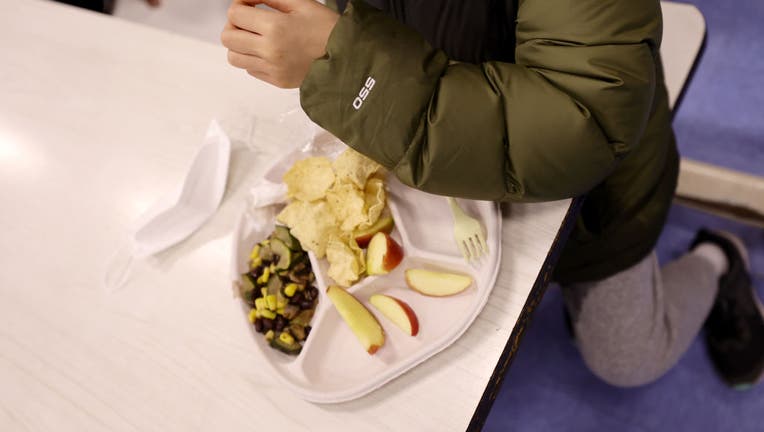No more pandemic-era free lunches at most US schools this year

A student eats a meal served for lunch at a school on Feb. 4, 2022, in New York City. (Photo by Michael Loccisano/Getty Images)
As U.S. families prepare for the start of a new school year, there will likely be changes involving school meals — including the end of free lunches for many public schools across the country.
Federal aid given during the COVID-19 pandemic made school meals available for free to all public school students — regardless of family income levels. But some of those eligibility waivers expired over the summer, so beginning with the 2022-2023 school year, many districts will no longer be serving all of their meals for free.
Instead, families will do what they did before the pandemic, in which schools take applications and use a family’s income to qualify kids for free, reduced-price, or fully-paid meals, according to the U.S. Department of Agriculture’s Food and Nutrition Service.
Schools in predominantly low-income areas also use a program called the "Community Eligibility Provision" that helps them serve breakfast and lunch to everyone for free, as before. Parents can contact their local school to see if they are part of the program, or click here to view eligible districts and schools by state.
How schools offered free meals during pandemic
The pandemic disrupted many aspects of education, including the ability of public schools to continue offering quality meals through government child nutrition programs.
At the onset of the crisis, the USDA, which administers the federal government’s National School Lunch Program, granted COVID-19 waivers to increase flexibility and meet the dietary needs of children during a time hampered by strict regulations.
This included the ability for schools to serve grab-and-go meals, offer flexibility on nutrition requirements amid pandemic shortages, as well as the ability for school systems to serve meals to students at no cost through the National School Lunch Program’s Seamless Summer Option (SSO) without verifying families’ income.
"Allowing school food authorities to participate under SSO during COVID–19 operations during the regular school year facilitates the safe provision of meals by eliminating the need to collect meal payments, including cash payments, at meal sites," the USDA said in an April 2021 memo, noting how up to 12 million U.S. children were living in households where they may not always have enough to eat.
The waivers were renewed several times and expired at the end of June. That same month, President Joe Biden signed legislation that aimed to keep the rules around summer meal programs as they have been during the pandemic so that sites could operate in any community with need — rather than just where there’s a high concentration of low-income children — and offer to-go meals.
It also provided flexibility for schools to make substitutions for certain types of food without being fined if they run into supply chain problems.
Parents brace for end, while some states make school meals free
When school meals were made available to students nationwide, many parents welcomed the relief as one less thing to worry about during the pandemic. But now, with Americans already strained by high inflation, advocates say this will likely be a hardship for many families.
"We make just too much money (literally by just a few dollars) to qualify for free or reduced lunches and other food-related benefits, but not enough to truly ever feel financially comfortable," Kate Murphy, a mother of four and administrator at a trust company in Vermont, told the Associated Press earlier this summer.
For the 2022-2023 school year, some states have taken it upon themselves to keep school meals free for all students.
California and Maine made universal meals permanent in 2021. Vermont, where Murphy and her family live, is continuing the free meals for all public school students for another year using surplus state education funding.
In Massachusetts, the governor signed a one-time $110 million investment to extend universal school meals for another year. In Colorado, the Legislature passed a bill to ask voters this November whether to fund free universal breakfast and lunch at schools.
Cheap (and healthy) school lunch ideas
Given these changes, some parents may be seeking affordable and healthy options for school lunches. Evelyn Benden, pediatric registered dietitian for Cleveland Clinic Children’s, advises parents to make sure they’re packing all the different food groups.
"So packing fruits, vegetables, protein, grains and dairy. A lot of times we’re just packing a sandwich and chips or something like that," Benden said, noting how what children eat can affect their energy levels and ability to concentrate.
School lunches don’t have to be elaborate. Benden said simple items like whole wheat crackers, deli meat, low-fat cheese and yogurt are all good options. Other ideas include chicken, hard-boiled eggs, hummus, beans, mixed nuts, carrots, apple slices or a peeled clementine.
Leftovers from dinner are always a good option, as well as meal prepping — which can save both time and money.
"You don’t want to put things in their lunch that they really don’t like because they’re definitely not going to eat them," Benden explained. "So maybe the foods that are harder, have home at dinner or on the weekends and pick things that you know they’re able to eat."
Cafeteria lunches must follow certain nutritional guidelines. But Benden said it doesn’t hurt to look at the meal calendar ahead of time "so you can tell your child what foods to pick and what to avoid."
This story was reported from Cincinnati.



